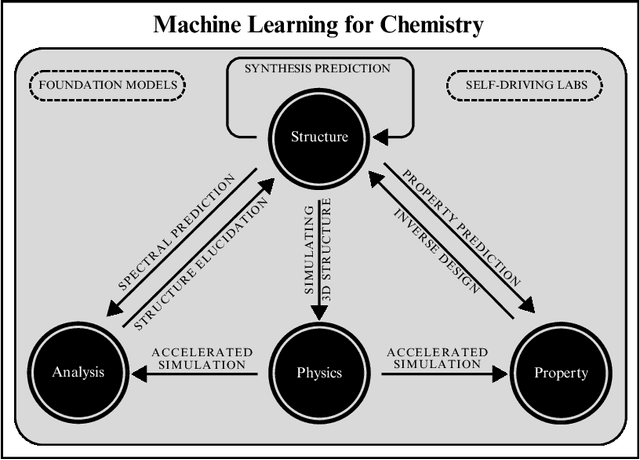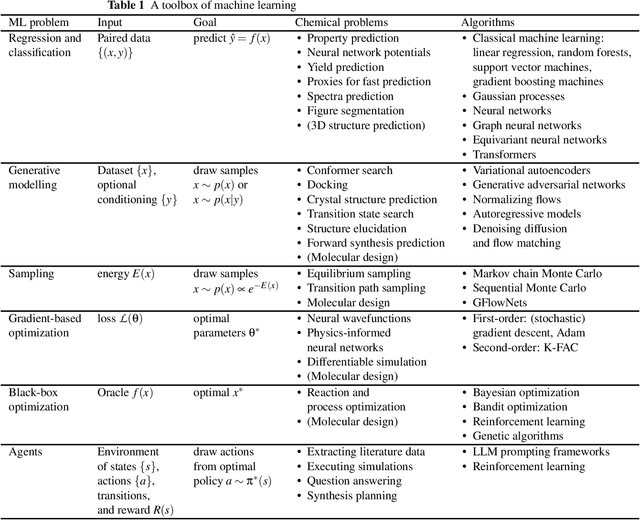Luca Thiede
DEQuify your force field: More efficient simulations using deep equilibrium models
Sep 10, 2025Abstract:Machine learning force fields show great promise in enabling more accurate molecular dynamics simulations compared to manually derived ones. Much of the progress in recent years was driven by exploiting prior knowledge about physical systems, in particular symmetries under rotation, translation, and reflections. In this paper, we argue that there is another important piece of prior information that, thus fa,r hasn't been explored: Simulating a molecular system is necessarily continuous, and successive states are therefore extremely similar. Our contribution is to show that we can exploit this information by recasting a state-of-the-art equivariant base model as a deep equilibrium model. This allows us to recycle intermediate neural network features from previous time steps, enabling us to improve both accuracy and speed by $10\%-20\%$ on the MD17, MD22, and OC20 200k datasets, compared to the non-DEQ base model. The training is also much more memory efficient, allowing us to train more expressive models on larger systems.
ELECTRA: A Symmetry-breaking Cartesian Network for Charge Density Prediction with Floating Orbitals
Mar 11, 2025Abstract:We present the Electronic Tensor Reconstruction Algorithm (ELECTRA) - an equivariant model for predicting electronic charge densities using "floating" orbitals. Floating orbitals are a long-standing idea in the quantum chemistry community that promises more compact and accurate representations by placing orbitals freely in space, as opposed to centering all orbitals at the position of atoms. Finding ideal placements of these orbitals requires extensive domain knowledge though, which thus far has prevented widespread adoption. We solve this in a data-driven manner by training a Cartesian tensor network to predict orbital positions along with orbital coefficients. This is made possible through a symmetry-breaking mechanism that is used to learn position displacements with lower symmetry than the input molecule while preserving the rotation equivariance of the charge density itself. Inspired by recent successes of Gaussian Splatting in representing densities in space, we are using Gaussians as our orbitals and predict their weights and covariance matrices. Our method achieves a state-of-the-art balance between computational efficiency and predictive accuracy on established benchmarks.
How to do impactful research in artificial intelligence for chemistry and materials science
Sep 16, 2024

Abstract:Machine learning has been pervasively touching many fields of science. Chemistry and materials science are no exception. While machine learning has been making a great impact, it is still not reaching its full potential or maturity. In this perspective, we first outline current applications across a diversity of problems in chemistry. Then, we discuss how machine learning researchers view and approach problems in the field. Finally, we provide our considerations for maximizing impact when researching machine learning for chemistry.
Sorting Out Quantum Monte Carlo
Nov 09, 2023Abstract:Molecular modeling at the quantum level requires choosing a parameterization of the wavefunction that both respects the required particle symmetries, and is scalable to systems of many particles. For the simulation of fermions, valid parameterizations must be antisymmetric with respect to the exchange of particles. Typically, antisymmetry is enforced by leveraging the anti-symmetry of determinants with respect to the exchange of matrix rows, but this involves computing a full determinant each time the wavefunction is evaluated. Instead, we introduce a new antisymmetrization layer derived from sorting, the $\textit{sortlet}$, which scales as $O(N \log N)$ with regards to the number of particles -- in contrast to $O(N^3)$ for the determinant. We show numerically that applying this anti-symmeterization layer on top of an attention based neural-network backbone yields a flexible wavefunction parameterization capable of reaching chemical accuracy when approximating the ground state of first-row atoms and small molecules.
Towards equilibrium molecular conformation generation with GFlowNets
Oct 20, 2023



Abstract:Sampling diverse, thermodynamically feasible molecular conformations plays a crucial role in predicting properties of a molecule. In this paper we propose to use GFlowNet for sampling conformations of small molecules from the Boltzmann distribution, as determined by the molecule's energy. The proposed approach can be used in combination with energy estimation methods of different fidelity and discovers a diverse set of low-energy conformations for highly flexible drug-like molecules. We demonstrate that GFlowNet can reproduce molecular potential energy surfaces by sampling proportionally to the Boltzmann distribution.
Wasserstein Quantum Monte Carlo: A Novel Approach for Solving the Quantum Many-Body Schrödinger Equation
Jul 17, 2023Abstract:Solving the quantum many-body Schr\"odinger equation is a fundamental and challenging problem in the fields of quantum physics, quantum chemistry, and material sciences. One of the common computational approaches to this problem is Quantum Variational Monte Carlo (QVMC), in which ground-state solutions are obtained by minimizing the energy of the system within a restricted family of parameterized wave functions. Deep learning methods partially address the limitations of traditional QVMC by representing a rich family of wave functions in terms of neural networks. However, the optimization objective in QVMC remains notoriously hard to minimize and requires second-order optimization methods such as natural gradient. In this paper, we first reformulate energy functional minimization in the space of Born distributions corresponding to particle-permutation (anti-)symmetric wave functions, rather than the space of wave functions. We then interpret QVMC as the Fisher-Rao gradient flow in this distributional space, followed by a projection step onto the variational manifold. This perspective provides us with a principled framework to derive new QMC algorithms, by endowing the distributional space with better metrics, and following the projected gradient flow induced by those metrics. More specifically, we propose "Wasserstein Quantum Monte Carlo" (WQMC), which uses the gradient flow induced by the Wasserstein metric, rather than Fisher-Rao metric, and corresponds to transporting the probability mass, rather than teleporting it. We demonstrate empirically that the dynamics of WQMC results in faster convergence to the ground state of molecular systems.
Waveflow: Enforcing boundary conditions in smooth normalizing flows with application to fermionic wave functions
Nov 27, 2022



Abstract:In this paper, we introduce four main novelties: First, we present a new way of handling the topology problem of normalizing flows. Second, we describe a technique to enforce certain classes of boundary conditions onto normalizing flows. Third, we introduce the I-Spline bijection, which, similar to previous work, leverages splines but, in contrast to those works, can be made arbitrarily often differentiable. And finally, we use these techniques to create Waveflow, an Ansatz for the one-space-dimensional multi-particle fermionic wave functions in real space based on normalizing flows, that can be efficiently trained with Variational Quantum Monte Carlo without the need for MCMC nor estimation of a normalization constant. To enforce the necessary anti-symmetry of fermionic wave functions, we train the normalizing flow only on the fundamental domain of the permutation group, which effectively reduces it to a boundary value problem.
 Add to Chrome
Add to Chrome Add to Firefox
Add to Firefox Add to Edge
Add to Edge